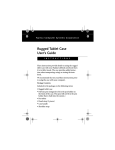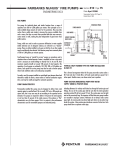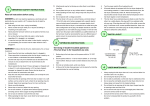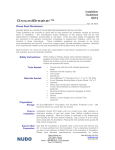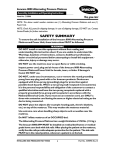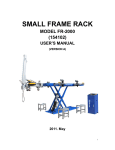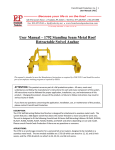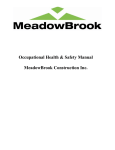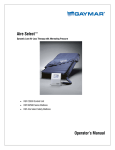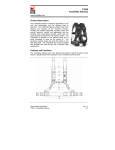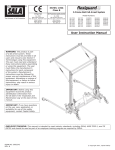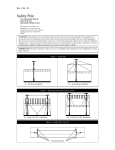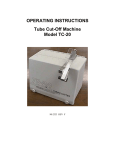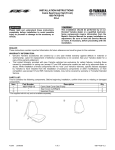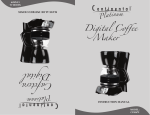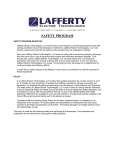Download eLCOSH: FOCUS 4 Hazards
Transcript
www.buildsafe.org FOCUS 4 HAZARDS ENGLISH Electrocutions Fall Protection Struck-By Caught Inbetween FOCUS 4 HAZARDS Employee general safety Each employee must understand that there is a certain responsibility they must take to ensure their safety on the construction site. To maintain a level of safety each employee must follow basic guidelines as follows: 1. insist on receiving and reviewing a copy of the company’s safety and health program and policies before beginning work. 2. Comply with all established safety rules and regulations on the site. 3. Immediately report all unsafe equipment, materials or situations to the supervisor. 4. Immediately report all accidents and or injuries to the supervisor. 5. If unsure about the proper tools or Personal Protective Equipment needed to complete a task, immediately ask a supervisor. 6. Know the emergency telephone numbers and actions to take during an emergency. 7. Maintain a safe and clean work area by monitoring debris and other materials in the work area. 8. Participate in safety training and ask questions if you do not understand a topic. 9. Set a good example for others to follow. 10. Work with others to maintain a safe work environment. 11. Be aware of other workers on the site for hazards they may create. Chicagoland WRONG WAY RIGHT WAY Chicagoland 4 3 2 W www.buildsafe.org 2 — English FOCUS 4 HAZARDS Housekeeping The areas within and surrounding the construction site can become very hazardous to workers if the debris created from the activities on the site are allowed to build up. Follow these tips to keep your worksite clean and to reduce possible injury: 1. All floors, walkways, and stairs must be kept in good repair. Keep them free of anything that may cause a slip or trip hazard. 2. Do not allow waste materials to build-up in working areas (around saw horses, cutting stations, tool boxes). Maintain an ongoing routine of waste disposal at regular intervals. 3. Maintain adequate lighting in all work areas. 4. Use waste bins, garbage cans, and dumpsters to prevent the build-up of debris 5. Ensure that there are no protruding nails on loose or fixed materials that may snag clothing or cause an abrasion or puncture. 6. Post signs and use danger or caution tape where hazards might not be readily seen on the job-site. 7. Ensure that all ground surfaces are firm and level before setting scaffolds or ladders. Chicagoland WRONG WAY RIGHT WAY www.buildsafe.org 3 — English FOCUS 4 HAZARDS Material handling safety The areas within and surrounding the construction site can become very hazardous to workers if the debris created from the activities on the site are allowed to build up. Follow these tips to keep your worksite clean and to reduce possible injury: 1. All floors, walkways, and stairs must be kept in good repair. Keep them free of anything that may cause a slip or trip hazard. 2. Do not allow waste materials to build-up in working areas (around saw horses, cutting stations, tool boxes). Maintain an ongoing routine of waste disposal at regular intervals. 3. Maintain adequate lighting in all work areas. 4. Use waste bins, garbage cans, and dumpsters to prevent the build-up of debris 5. Ensure that there are no protruding nails on loose or fixed materials that may snag clothing or cause an abrasion or puncture. 6. Post signs and use danger or caution tape where hazards might not be readily seen on the job-site. 7. Ensure that all ground surfaces are firm and level before setting scaffolds or ladders. Chicagoland WRONG WAY RIGHT WAY www.buildsafe.org 4 — English FOCUS 4 HAZARDS Personal protective equipment (PPE) 1. 2. 3. 4. 1. 2. 1. 2. 1. 2. 1. Eye and Face Protection Safety glasses or face shields are worn any time work operations can cause foreign objects to get in the eye. For example, during welding, cutting, grinding, nailing (or when working with concrete and/or harmful chemicals or when exposed to flying particles). Wear when exposed to any electrical hazards, including working on energized electrical systems. Eye and face protectors – select based on anticipated hazards. Foot Protection Construction workers should wear work shoes or boots with slip-resistant and puncture-resistant soles. Safety-toed footwear is worn to prevent crushed toes when working around heavy equipment or falling objects. Hand Protection Gloves should fit snugly. Workers should wear the right gloves for the job (examples: heavy-duty rubber gloves for concrete work; welding gloves for welding; insulated gloves and sleeves when exposed to electrical hazards). Head Protection Wear hard hats where there is a potential for objects falling from above, bumps to the head from fixed objects, or of accidental head contact with electrical hazards. Hard hats – routinely inspect them for dents, cracks or deterioration; replace after a heavy blow or electrical shock; maintain in good condition. Hearing Protection Use earplugs/earmuffs in high noise work areas where chainsaws or heavy equipment are used; clean or replace earplugs regularly. Chicagoland Ear Muffs or Plugs Face Shield, Saftey Glasses or Goggles 4 W Gloves Apron or Vest 2 Boots WRONG WAY Chicagoland www.buildsafe.org 5 — English RIGHT WAY FOCUS 4 HAZARDS Health hazards Hazards to an employee’s health can come from other areas that in some instances can be overlooked. Some of these hazards occur due to the materials used in construction or they are the by product of one or more job site activities. Training should be provided to all employees on how substances at work can negatively affect their health and well being. Exposure to Asbestos, Lead and Silica have been identified as health hazards on construction job sites. ASBESTOS • Used in older buildings for insulation, heat and fire resistance • Used in electrical, pipe, and roof insulation for heat and fire resistance • The inhalation of asbestos fibers can cause serious illnesses, lung cancer, and/or calcifications in the lung. Since the mid 1980s, many uses of asbestos have been banned in many countries. LEAD • Because lead is very easy to work with and resistant to corrosion it is extensively used in building construction, external coverings of roofing joints, pipe solder and in paints. • Lead is a potent neurotoxin that accumulates in soft tissues and bone over time and cause blood and brain disorders. • Lead may still be found in harmful quantities in vinyl (such as that used for tubing and the insulation of electrical cords). • Old paint should not be stripped by sanding, as this produces inhalable dust. SILICA • Silica is most commonly found in nature as sand or quartz, it is a principal component of most types of glass and substances such as concrete, mortar mix, stucco, and stone. • Inhaling silica dust in very small quantities over time can lead to silicosis, bronchitis or (much more rarely) cancer, as the dust becomes lodged in the lungs and continuously irritates them, reducing lung capacities (silica does not dissolve over time). Protection from these job site health hazards • Work rules to avoid exposure (only specifically trained workers do work) • Engineering controls (such as wet cutting concrete or block) • Personal Protective Equipment (respirator) • If asked to wear a respirator by an employer, additional training and a medical evaluation must be provided by employer before wearing a respirator. Chicagoland Chicagoland Chicagoland WRONG WAY www.buildsafe.org 6 — English RIGHT WAY FOCUS 4 HAZARDS Ladder safety 1. Choose the right equipment. Use ladders mainly for climbing to or from other levels. 2. Choose the right ladder length. 3. A sticker on a commercial ladder tells you its maximum weight capacity. Use only type I, IA, or IAA ladders. Ladder rungs, cleats, and steps must be parallel, level, and evenly spaced 4. The rungs and steps of metal ladders must be grooved or roughened to minimize slipping. Side rails must be at least 11.5 inches apart. 5. If you use two or more ladders to reach one spot, they must have a platform or landing between them. 6. Ladder parts must be smooth to prevent punctures or cuts or snagging of clothing. 7. Wood ladders must not be painted with a coating that can hide defects. 8. Stepladders: All four legs must be on solid, level ground. The spreaders must be locked fully open. 9. Never climb on the cross-bracing. Never lean a stepladder against a wall. 10. Straight and extension ladders: The ladder base should be 1 foot from the building (or top support, such as an eave) for every 4 feet of ladder length up to the resting position. Counting rungs will give you a good estimate of the ladder length; rungs are about 1 foot apart. 11. When working from or climbing keep yourself positioned between the rails of the ladder. Chicagoland 4 1 WRONG WAY RIGHT WAY www.buildsafe.org 7 — English FOCUS 4 HAZARDS Protect yourself - fall harness Whenever fall protection is needed, make sure you have the right fall-protection system, know how it works, get trained to use it – and use it. When eliminating the hazard and guardrails, or safety nets won’t work, you need personal protective equipment (PPE) – fall-restraint systems, personal fall-arrest systems. Restraint systems keep you from falling. Fallarrest systems stop falls. You will need a full-body harness if you use one of these systems. A full-body harness has straps worn around your trunk and thighs, with one or more Drings in back to attach the harness to other parts of the system. Choosing a Harness 1. Learn about the types of fall hazards on your job. 2. Make sure the harness fits you and is comfortable, to prevent body strain. you can get shoulder and back pads to reduce harness pressure. Full-body cross-chest harnesses are more comfortable for women and can reduce bruising when falls are stopped. Training 1. The employer must fit and train each worker for the equipment to be used. 2. A competent person must train workers at risk of falling about types of fall hazards, how to protect yourself, and other hazards and limitations in using fall protection. **Training must cover all that can happen, like hanging in a harness and rescue. 3. If the worksite changes or the type of fall protection equipment is changed, workers using the equipment must be retrained. Chicagoland 6’+ Front 6’+ Back Back WRONG WAY RIGHT WAY Chicagoland www.buildsafe.org 8 — English Front FOCUS 4 HAZARDS Scaffolding 1. 2. 3. 4. 5. 6. 7. 1. 2. 3. 4. 5. 6. 7. 8. 9. 10. 11. All scaffolding inspected daily by competent person Erected on sound rigid footing Base plates and mudsill are being used Tied to structure, if required Guardrails in place; top rail, intermediate, and toe board Sturdy and sound planking on all working levels Proper access provided General Requirements Support own weight and 4X’s intended load Platform fully planked or decked (no gaps greater than 1”) Front edge of platform no more than 14” from face of work Planks extend at least 6” but not more than 12” past support Planks overlap 12” over supports No mixed scaffold components If higher than 4:1 ratio, restrained from tipping Maintain power line clearance No work during storms or high wind Fall protection required at 10’ No climbing cross braces for access Chicagoland WRONG WAY RIGHT WAY www.buildsafe.org 9 — English FOCUS 4 HAZARDS Aerial lifts- safety tips The major causes of fatalities are falls, electrocutions, and collapses or tip overs. 1. Ensure that workers who operate aerial lifts are properly trained in the safe use of the equipment. 2. Maintain and operate elevating work platforms in accordance with the manufacturer’s instructions. 3. Never override hydraulic, mechanical, or electrical safety devices. 4. Never move the equipment with workers in an elevated platform unless this is permitted by the manufacturer. 5. Do not allow workers to position themselves between overhead hazards, such as joists and beams, and the rails of the basket. Movement of the lift could crush the worker(s). 6. Maintain a minimum clearance of at least 10 feet, or 3 meters, away from the nearest overhead lines. 7. Always treat powerlines, wires and other conductors as energized, even if they are down or appear to be insulated. 8. Use a body harness with a lanyard attached to the boom or basket to prevent the worker(s) from being ejected or pulled from the basket. 9. Set the brakes, and use wheel chocks when on an incline. 10. Use outriggers, if provided. 11. Do not exceed the load limits of the equipment. Allow for the combined weight of the worker, tools, and materials. Chicagoland Line Clearance Distance 10’ Min. WRONG WAY RIGHT WAY www.buildsafe.org 10 — English FOCUS 4 HAZARDS Overhead power lines Overhead and buried power lines at your site are especially hazardous because they carry extremely high voltage. Fatal electrocution is the main risk, but burns and falls from elevations are also hazards. Using tools and equipment that can contact power lines increases the risk. Examples of Equipment That Can Contact Power Lines 1. Aluminum paint rollers 2. Backhoes 3. Concrete pumpers 4. Cranes 5. Long-handled cement finishing floats 6. Metal building materials 7. Metal ladders 8. Raised dump truck beds 9. Scaffolds How Do I Avoid Hazards? 1. Look for overhead power lines and buried power line indicators. Post warning signs. 2. Contact utilities for buried power line locations. 3. Stay at least 10 feet away from overhead power lines. 4. Unless you know otherwise, assume that overhead lines are energized. 5. De-energize and ground lines when working near them. Other protective measures include guarding or insulating the lines. 6. Use non-conductive wood or fiberglass ladders when working near power lines. Chicagoland WRONG WAY RIGHT WAY www.buildsafe.org 11 — English FOCUS 4 HAZARDS Electrical safety- GFCI 1. 2. 3. 4. 5. 6. 7. 8. 9. Ground fault circuit protection is required on all 120 Volt single phase temporary electrical power supply outlets on jobsites. Shocks, burns and fatalities can be the result of contact with live wiring or faulty electrical equipment. Think about the environment in which you will be using electrical equipment, wet and damp locations add hazards to the job. Make sure to inspect all cord, cordsets, tools, and receptacles before using. Only use three wire type extension cords designed for hard or extra hard service. Look for cut , frayed or nicked insulation on the jackets of cord sets and equipment. Do not use tape to repair or conceal a damaged cord. Insure all three prong plugs have the grounding pin intact and never remove the ground pin. If a cord has damage be sure to discard, tag “Do Not Use” or have a qualified electrician make the appropriate repair. Chicagoland Frayed Wire No Ground Pin WRONG WAY RIGHT WAY www.buildsafe.org 12 — English FOCUS 4 HAZARDS Power tool hazards The types of power tools are determined by power source: electric, pneumatic, liquid fuel, hydraulic, and powder-actuated. To prevent hazards associated with the use of power tools, workers should observe the following general precautions: 1. Never carry a tool by the cord or hose. 2. Never yank the cord or the hose to disconnect it from their receptacle. 3. Keep cords and hoses away from heat, oil, and sharp edges. 4. Disconnect tools when not using them, before servicing and cleaning them, and when changing accessories such as blades, bits, and cutters. 5. Keep all people not involved with the work at a safe distance from the work. 6. Secure work with clamps or a vise, freeing both hands to operate the tool. 7. Avoid accidental starting. Do not hold fingers on the switch button while carrying a plugged-in tool. 8. Maintain tools with care; keep them sharp and clean for best performance. 9. Follow instructions in the user’s manual for lubricating and changing accessories. 10. Be sure to keep good footing and maintain good balance when operating power tools. 11. Wear proper apparel for the task. Loose clothing, ties, or jewelry can be come caught in moving parts. 12. Remove all damaged portable electric tools from use and tag them: “Do Not Use.” Chicagoland No Hat No Safety Goggles No Protection Lifting Tool by the Cord Frayed Wire DO NO USET Cord ith gw Plu Angle ing Pull on an WRONG WAY Chicagoland RIGHT WAY 4 3 2 W www.buildsafe.org 13 — English FOCUS 4 HAZARDS Machine guarding The point of operation is where work is performed on the material, such as cutting, shaping, boring, or forming of stock. These components include flywheels, pulleys, belts, connecting rods, couplings, cams, spindles, chains, cranks, and gears Crushed hands and arms, severed fingers and limbs, lacerations and abrasions safeguards are essential for protecting workers from preventable injuries. 1. Guards must not create potential hazards and must be attached to the machine where possible. 2. If guards cannot be attached to the machine, attach elsewhere. 3. Rotating motion can be dangerous; even smooth, slowly rotating shafts can grip hair and clothing. In-running nip point hazards are caused by the rotating parts on machinery. 4. Nip points can occur between rotating and fixed parts which create a shearing, crushing, or abrading action. 5. Reciprocating motions may be hazardous because, during the back-and-forth or up-and-down motion, a worker may be struck by or caught between a moving and a stationary part. 6. Objects with movement in straight, continuous lines creates a hazard because a worker may be struck or caught in a pinch or shear point by the moving part. 7. Cutting action may involve rotating, reciprocating, or transverse motion. 8. The danger of cutting action exists at the point of operation where finger, arm and body injuries can occur and where flying chips or scrap material can strike the head, particularly in the area of the eyes or face. Chicagoland No Face Shield, No Safety Glasses No Goggles No Hat and Long Hair Face Shield, or Safety Glasses or Goggles, Hat and No Long Hair No Guard Safety Guard Let Blade pull Stock Pushing Stock WRONG WAY RIGHT WAY www.buildsafe.org 14 — English FOCUS 4 HAZARDS Trench and excavation safety Each employee in a trench shall be protected from a cave-in by an adequate protective system Some of the protective systems for trenches are: 1. Trench has been sloped for stability 2. Cut to create stepped benched grades 3. Supported by a system made with posts, beams, shores or planking and hydraulic jacks 4. Supported by a trench box to protect workers in a trench. 5. Additionally, excavated or other materials must be at least 2 feet back from the edge of a trench 6. Safe means of egress shall be provided within 25 feet of workers in a trench Also be aware of the following conditions that can affect the stability of the trench itself. 1. Location of traffic 2. Changes in weather conditions 3. Vibrations caused by machinery 4. Physical conditions of nearby structures 5. Surface or groundwater or water in trench 6. Overhead or underground utilities Chicagoland 10’ Min. Clearance 3’ 2’ :1 : .75 :1 1 1.5 1 WRONG WAY RIGHT WAY www.buildsafe.org 15 — English FOCUS 4 HAZARDS Cranes and rigging Properly securing any load with appropriate rigging is crucial to any lifting being done by machinery on the job-site. If the rigging fails the results can cause serious injury and even death. Before any load is lifted all components of the rigging hardware should be evaluated to ensure they can withstand the forces of the load. Follow these safe work practices 1. Guard all exposed gears, rotating shafts, pulleys, sprockets or other moving parts to prevent contact with employees. 2. Guard or block the swing radius of the crane to restrict and prevent employees from entering into and being struck by the machine. 3. Inspect all rigging equipment prior to each lift, this should include all slings, chains, ropes, and like materials used to support and lift materials. 4. Remove from service any defective equipment immediately. 5. Be sure to inspect all hooks, clamps, and other lifting accessories for their rated load. 6. Clearly communicate to all employees on site that no one is permitted to work under loads. 7. Be sure the person responsible for signaling the crane operator stays in visual contact with the operator and has been trained to use the correct signals. Chicagoland Line Clearance Distance 10’ Min. WRONG WAY RIGHT WAY www.buildsafe.org 16 — English FOCUS 4 HAZARDS Work zone traffic safety 1. 2. 3. 4. 5. 6. 7. 8. Work zones need traffic controls identified by signs, cones, barrels and barriers. Drivers, employees on foot, and pedestrians must be able to see and understand the proper routes. Traffic control devices, signals, and message boards instruct drivers to follow paths away from where work is being done. Approved traffic control devices, including cones, barrels, barricades, and posts are also used inside work zones. Work Zone Protections: Various concrete, water, sand, collapsible barriers, crash cushions, and truck-mounted attenuatorscan help limit motorist intrusions into construction work zones. Flagging: Flaggers should wear high visibility clothing with a fluorescent background and made of retroreflective material. This makes employees visible for at least 1,000 feet in any direction. Check the label or packaging to ensure that the garments are performance class 2 or 3. Drivers should be warned with signs that there will be flaggers ahead. Flaggers should use STOP SLOW paddles, paddles with lights, or flags (only in emergencies). Training: Flaggers must be trained certified and use authorized signaling methods. Driving: Seat belts and rollover protection should be used on equipment and vehicles as the manufacturer recommends. Chicagoland STOP SLOW FLAGGER AHEAD Buffer Space (Lateral) 1 - Advance Warning Area 2 - Transition Area Traffic Space Buffer Space (Longitudinal) Work Space 3 - Activity Area WRONG WAY RIGHT WAY Chicagoland A www.buildsafe.org 17 — English 4 - Termination Area

















